Westview Primary serves 663 students in grades Prekindergarten-2.
The percentage of students achieving proficiency in math is 75-79% (which is higher than the South Carolina state average of 70%). The percentage of students achieving proficiency in reading/language arts is 80-84% (which is higher than the South Carolina state average of 71%).
The student:teacher ratio of 16:1 is higher than the South Carolina state level of 14:1.
Minority enrollment is 61% of the student body (majority Black), which is higher than the South Carolina state average of 53% (majority Black).
Quick Stats (2025)
- Grades: Prekindergarten-2
- Enrollment: 663 students
- Student:Teacher Ratio: 16:1
- Minority Enrollment: 61%
- Math Proficiency: 75-79%
- Reading Proficiency: 80-84%
- Source: National Center for Education Statistics (NCES), SC Dept. of Education
Top Rankings
Westview Primary ranks among the top 20% of public schools in South Carolina for:
Category
Attribute
Diversity
Percent Eligible For Free Lunch
School Overview
Westview Primary's student population of 663 students has declined by 8% over five school years.
The teacher population of 41 teachers has grown by 7% over five school years.
Grades Offered
Grades Prekindergarten-2
(offers virtual instruction)
(offers virtual instruction)
Total Students
663 students
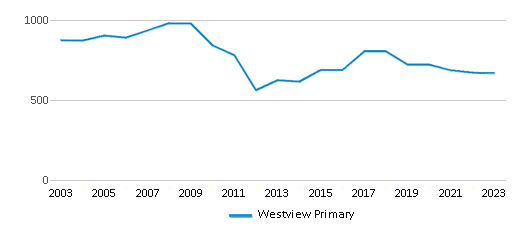
Gender %
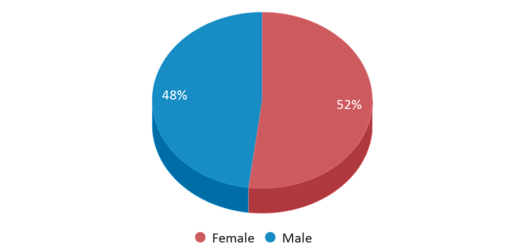
Total Classroom Teachers
41 teachers
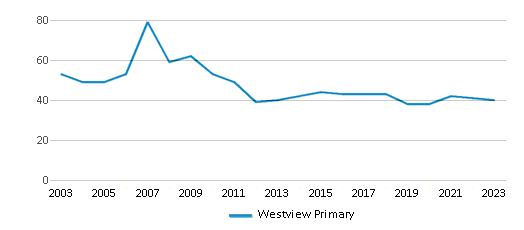
Students by Grade
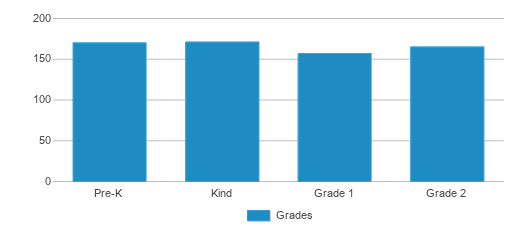
School Rankings
The diversity score of Westview Primary is 0.72, which is more than the diversity score at state average of 0.67. The school's diversity has stayed relatively flat over five school years.
Math Test Scores (% Proficient)
(10-11)75-79%
70%
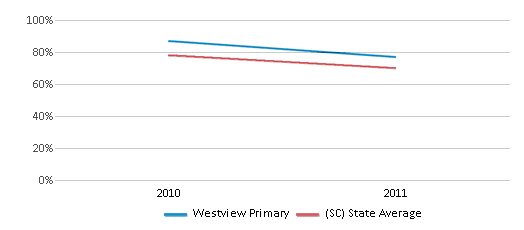
Reading/Language Arts Test Scores (% Proficient)
(10-11)80-84%
71%
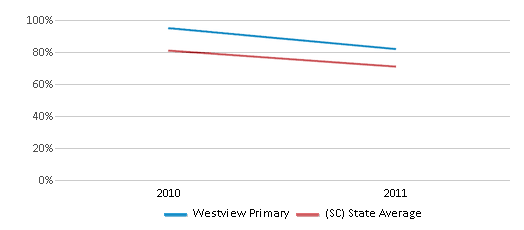
Student : Teacher Ratio
16:1
14:1
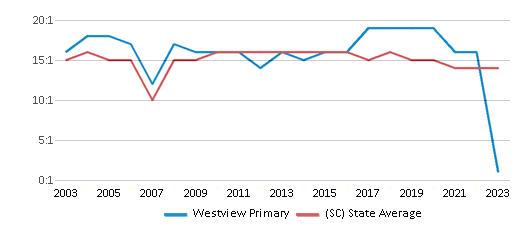
American Indian
n/a
n/a
Asian
1%
2%
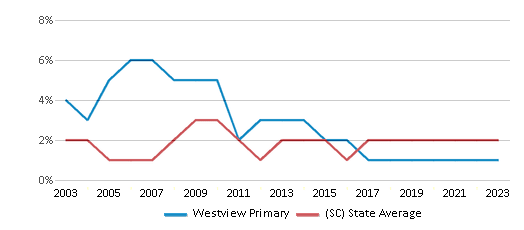
Hispanic
16%
14%
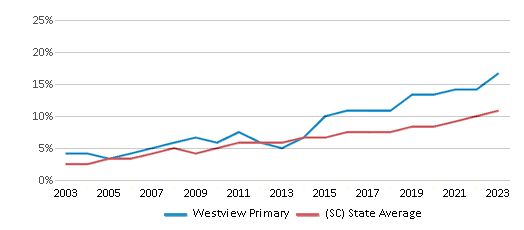
Black
30%
31%
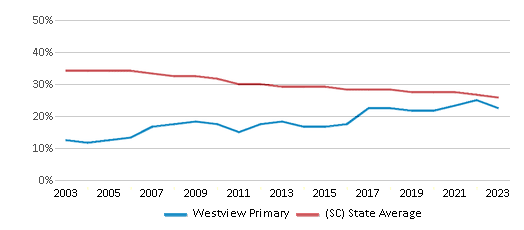
White
39%
47%
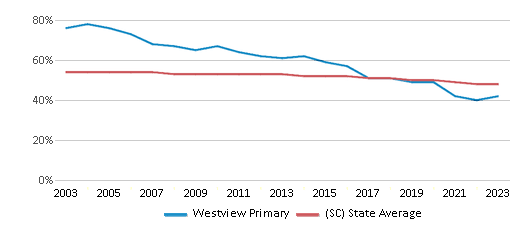
Hawaiian
n/a
n/a
Two or more races
14%
6%
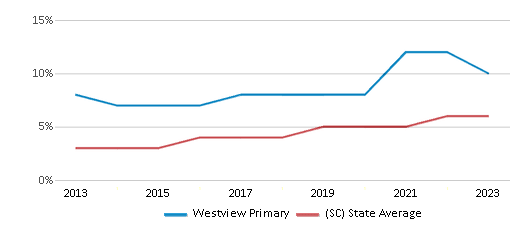
All Ethnic Groups
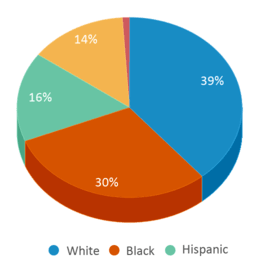
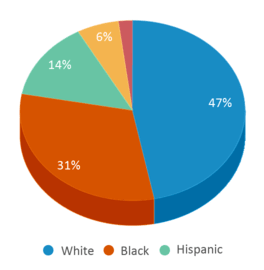
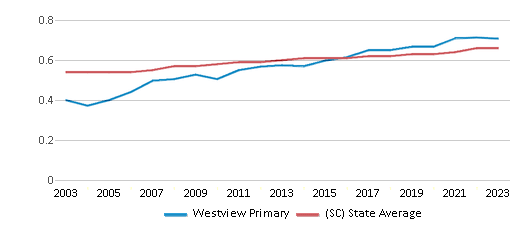
Participates in the National School Lunch Program (NSLP)
Yes
Eligible for Free Lunch
100%
67%
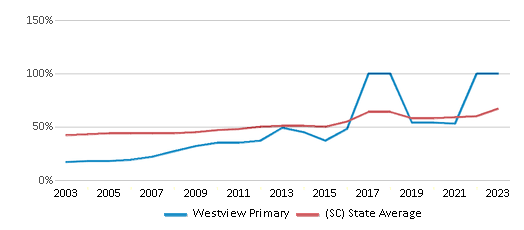
Eligible for Reduced Lunch (20-21)
4%
3%
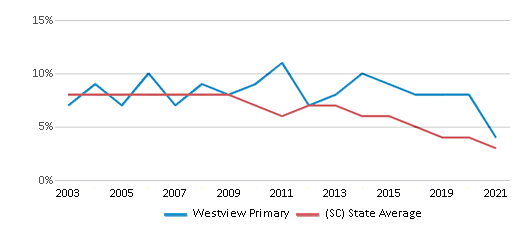
School Statewide Testing
School District Name
Source: National Center for Education Statistics (NCES), SC Dept. of Education
Profile last updated: 02/09/2025
Frequently Asked Questions
What percent of students have achieved state testing proficiency in math and reading?
75-79% of students have achieved math proficiency (compared to the 70% SC state average), while 80-84% of students have achieved reading proficiency (compared to the 71% SC state average).
How many students attend Westview Primary?
663 students attend Westview Primary.
What is the racial composition of the student body?
39% of Westview Primary students are White, 30% of students are Black, 16% of students are Hispanic, 14% of students are Two or more races, and 1% of students are Asian.
What is the student:teacher ratio of Westview Primary?
Westview Primary has a student ration of 16:1, which is higher than the South Carolina state average of 14:1.
What grades does Westview Primary offer ?
Westview Primary offers enrollment in grades Prekindergarten-2 (offers virtual instruction).
What school district is Westview Primary part of?
Westview Primary is part of Berkeley 01 School District.
School Reviews
5 1/29/2020
My kids go to west view primary school the student teacher Radio seem not true. It is 23-25 kids: 1 teacher they allow substitute teacher for a kindergarten class not for 2nd or 3rd grad.. it seems like play ground is quite small for the kids but before and after pick up system is very safely organized .
Review Westview Primary. Reviews should be a few sentences in length. Please include any comments on:
- Quality of academic programs, teachers, and facilities
- Availability of music, art, sports and other extracurricular activities
Recent Articles

What Is A Charter School?
Explore the world of charter schools in this comprehensive guide. Learn about their history, how they operate, and the pros and cons of this educational innovation. Discover key facts about charter schools, including admission policies, demographics, and funding, as well as what to look for when considering a charter school for your child.

10 Reasons Why High School Sports Benefit Students
Discover the 10 compelling reasons why high school sports are beneficial for students. This comprehensive article explores how athletics enhance academic performance, foster personal growth, and develop crucial life skills. From improved fitness and time management to leadership development and community representation, learn why participating in high school sports can be a game-changer for students' overall success and well-being.

February 05, 2025
Understanding the U.S. Department of Education: Structure, Impact, and EvolutionWe explore how the Department of Education shapes American education, from its cabinet-level leadership to its impact on millions of students, written for general audiences seeking clarity on this vital institution.

![From arts appreciation (ACE the Arts) to critical thinking (Da Vinci Programme), West Viewans are offered an array of opportunities to nurture their talents.
The school’s emphasis on values such as integrity and care, also helps to keep their students morally grounded. Pupils acquired the learning dispositions of perseverance, reflectiveness, inquisitiveness, dare and empathy to propel them into becoming passionate self-directed learners.
Come discover what makes West View Primary School so awesome at https://westviewpri.moe.edu.sg/
[Parts of the video were filmed before 2020]
============================================
Connect with us:
►Subscribe to channel: https://goo.gl/AaEGlb
►Facebook: http://facebook.com/moesingapore
►Instagram: http://instagram.com/moesingapore
►Twitter: http://twitter.com/MOEsg
►Online publication: http://schoolbag.sg
►Website: http://www.moe.gov.sg Westview Primary School - Every Child Matters](https://i.ytimg.com/vi/4DK1xKjpOZQ/0.jpg)







